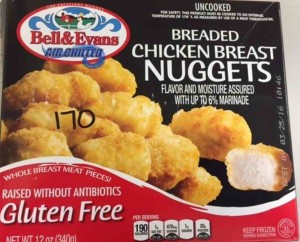Murry’s, Inc., a Lebanon, Pa. establishment, is recalling approximately 20,232 pounds of gluten-free breaded chicken nugget product that tested positive for Staphylococcal enterotoxin, the U.S. Department of Agriculture’s Food Safety and Inspection Service (FSIS) announced today.
 The following product is subject to recall: [View Labels (PDF Only)]
The following product is subject to recall: [View Labels (PDF Only)]
12-oz. boxes of “Bell & Evans Gluten Free Breaded Chicken Breast Nuggets” with a “Best By” date of March 25, 2016.
The product, bearing establishment number “P-516” inside the USDA mark of inspection, was shipped to an establishment for distribution nationwide.
The problem was discovered by the Colorado Department of Agriculture during a routine retail surveillance and sampling program, which is funded by the USDA at a Federal Emergency Response Network lab. After being notified of the positive test result, FSIS conducted traceback activities.
Staphylococcal food poisoning is a gastrointestinal illness. It is caused by eating foods contaminated with toxin-producing Staphylococcus aureus.
Staphylococcus aureus is a common bacterium found on the skin and in the noses of healthy people and animals. Staphylococcus aureus can produce seven different toxins that are frequently responsible for food poisoning.
Staphylococcal enterotoxins are fast acting, sometimes causing illness in as little as 30 minutes. Thoroughly cooking product does not prevent illness, and symptoms usually develop within one to six hours after eating contaminated food. Patients typically experience several of the following: nausea, vomiting, stomach cramps, and diarrhea. The illness is usually mild and most patients recover after one to three days.
To prevent Staphylococcal contamination, keep kitchens and food-serving areas clean and sanitized. Keep hot foods hot (over 140 °F) and cold foods cold (40 °F or under). Make sure to wash hands and under fingernails vigorously with soap and water before handling and preparing food. Do not prepare food if you have an open sore or wound on your hands or if you have a nose or eye infection.












